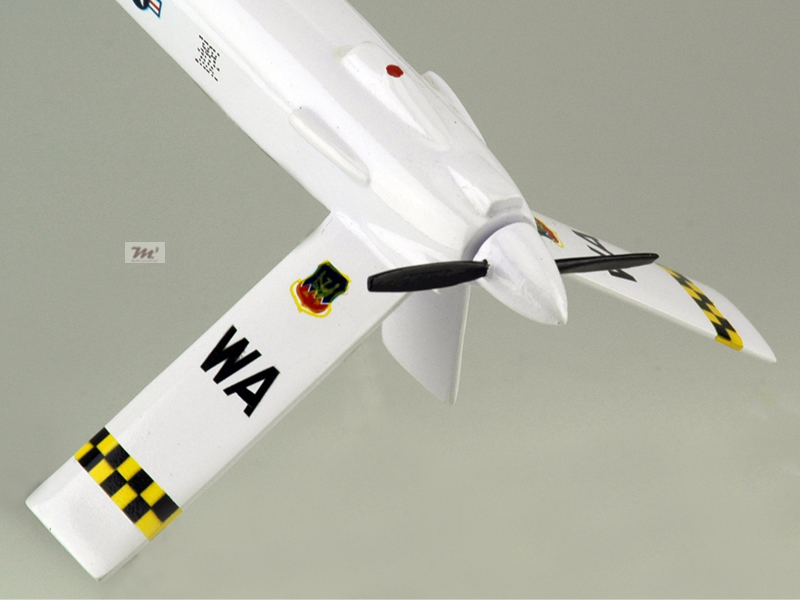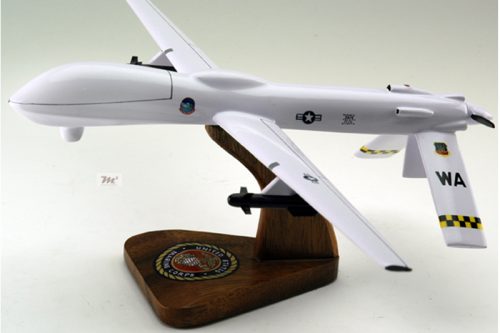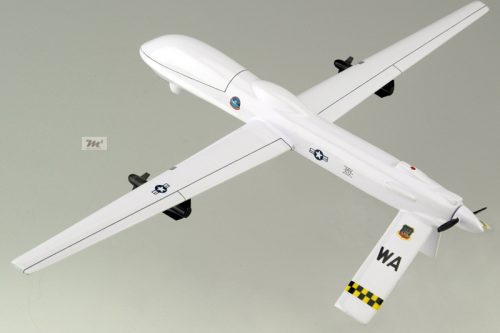Predator RQ-1A Model
Production Time 9 to 10 weeks
Shipment is by FedEx, UPS or DHL International Express Courier with a normal door-to-door delivery time worldwide of within 2-3 business days after dispatch. Due to the current volatility of world fuel prices, the amount mentioned here is our best estimate for DHL and UPS and may be subject to change at the time of shipping.

Product Statistics
Length: 9.5 Inches (24.1 Centimeters)Wingspan: 17.1 Inches (43.4 Centimeters)
Height: 2.4 Inches (6.1 Centimeters)
Scale: 1:34
$239.50
Manufacturer: General Atomics Aeronautical Systems
Production Time 9 to 10 weeks
-
United States dollar ($)
-
Pound sterling (£)
-
Euro (€)
-
Australian dollar ($)
-
Canadian dollar ($)
-
Singapore dollar ($)
-
Swiss franc (CHF)
-
Japanese yen (¥)
-
Danish krone (kr.)
-
Hong Kong dollar ($)
-
Norwegian krone (kr)
-
Swedish krona (kr)
General Product Description
Our MyMahoganyModel Predator RQ-1A Model exhibits unique, unrivaled quality and detailed design to come as close as possible to the accuracy of the actual plane. It comes as standard with a robust, durable base or stand which is available in a variety of different finishes designed to match your own personal requirements including solid wood, wood with polished metal supports or adjustable wood wall mount and will be ready within about 9-10 weeks from placement of order.
The Predator RQ-1A Model is made of the finest kiln dried renewable mahogany wood (commonly known as Lauan or Meranti) which has undergone many stages of carving and meticulous and careful sanding giving the beautiful, finished museum quality masterpiece. Many collectors and model connoisseurs demonstrate their preference for genuine handmade and hand painted mahogany wood models rather than plastic or die cast (diecast) alternatives due to the overall look and totally different feel of the item - we trust you will find the same. We can however, if required produce the same model in Solid Cast Resin so just click and contact us for further information. Our craftsmen and gifted artisans ensure that our finely handcrafted model airplanes match the precise blueprint details of the original aircraft. The paint scheme, markings and parts are closely matched, reflecting the original aircraft. This stylish top-quality desktop replica model will surely enthrall anyone who receives this as a gift and for sure one of the most appropriate and desirably collectable gifts for any military aviation enthusiast and avid aircraft collector whilst also displaying a perfect resemblance to the actual real life version.
There are many types of military propeller aircraft, but the basic types are bombers, fighters, fighter bombers, spotter planes, transporters, patrol aircraft, trainers, and reconnaissance and observation aircraft. All these types of aircraft are used for different types of missions. If you're a fan of historic or present-day military aviation, our model aircraft will bring the excitement and character of these aircraft right into your own home. You can order a wood airplane model of a North American B-25 Mitchell Bomber, a B17 - Flying Fortress, or a P-51 Mustang Nervous Energy V not forgetting the Bf 109, Spitfire, FW 190, A6M Zero, P-38 and F4U. These classic, propeller airplane models are of the highest quality. Each is individually crafted by our expert craftsmen. They produce handmade scale mahogany airplane models of the finest aircraft from World War I and II to present day biplanes and triplanes.
If you require, we can also make the Predator RQ-1A Model in any other military, government or even private livery or colour scheme you require and if necessary, in a different size or scale. Just click here to contact us with a description or photographs of what you require, and we will let you have a quotation for the necessary customization by return email. We can also make bespoke scale replicas of any other private / civil commercial airliner or airliners, helicopter, glider, gliders with engines, military jet, warplane jets, biplane, triplane, tail fin, spacecraft, rocket or NASA model you require in any airline, military or civilian livery or colors. We also produce model airships, blimps, dirigibles, blimps, boats, and ship collectibles. Wall plaque or seal for military, government or private customers. Again, by clicking here to contact us just let us know exactly what you need.
It is a Joint Forces Air Component Commander-owned theater asset for reconnaissance, surveillance and target acquisition in support of the Joint Force commander. The Predator can be employed in moderate risk areas without risking the life of the operator. Examples include areas where enemy air defenses have not been fully suppressed, open ocean environments, and biologically or chemically contaminated environments. .
The RQ-1A/B Predator is a system, not just an aircraft. The fully operational system consists of four air vehicles (with sensors), a ground control station (GCS), a Predator primary satellite link communication suite and 55 people. .
The Predator air vehicle and sensors are commanded and controlled by its GCS via a C-band line-of-sight data link or a Ku-band satellite data link for beyond-line-of-sight operations. During flight operations the crew in the GCS is an air vehicle operator and three sensor operators. The aircraft is equipped with a color nose camera (generally used by the air vehicle operator for flight control), a day variable aperture TV camera, a variable aperture infrared camera (for low light/night) and a synthetic aperture radar for looking through smoke, clouds or haze. The cameras produce full motion video and the synthetic aperture radar produces still frame radar images. On the RQ-1B, either the daylight variable aperture or the infrared electro-optical sensor may be operated simultaneously with the synthetic aperture radar. .
Each Predator air vehicle can be disassembled into six main components and loaded into a container nicknamed the casket. This enables all system components and support equipment to be rapidly deployed worldwide. The largest component is the GCS and it is designed to roll into a C-130 Hercules. The Predator primary satellite link consists of a 6.1 meter (20 ft) satellite dish and associated support equipment. The satellite link provides communications between the ground station and the aircraft when it is beyond line-of-sight and is a link to networks that disseminate secondary intelligence. The RQ-1A system needs 1,500 by 40 meters (5,000 by 125 ft) of hard surface runway with clear line-of-sight to each end from the GCS to the air vehicles. All components must be collocated on the same airfield. .
The improvements in the RQ-1B include an ARC-210 radio, an APX-100 IFF/SIF with mode 4, an ice mitigation system, up-graded, turbo-charged engine, and validated technical orders for operations and maintenance. A number of Predators have quick-reaction laser designators so they can act as airborne forward air controllers for allied tactical aircraft. Following a series of tests in 2001, some of those Predators have been armed with AGM-114 Hellfire missiles guided by those laser designators. .
On February 7, 2002, an armed Predator attacked a convoy of sport utility vehicles, killing a suspected al Qaeda leader. The intelligence community initially expressed doubt that he was Osama bin Laden. .
On November 3, 2002, the CIA used a Predator again in an assassination. A Hellfire missile was fired at a car in Yemen, killing Qaed Senyan al-Harthi, an al-Qaeda leader thought to be responsible for the USS Cole bombing. It was the first direct US strike in the War on Terror that was not in Afghanistan. .
The R is the Department of Defense designation for reconnaissance; Q means unmanned aircraft system. The 1 describes it as being the first of a series of purpose-built unmanned reconnaissance aircraft systems. The A says it is the pre-production version of the RQ-1 system series while the B denotes the baseline production configuration. See also RQ-2 Pioneer, RQ-3 Dark Star, RQ-4 Global Hawk, RQ-5 Hunter, RQ-6 Outrider, and RQ-7 Shadow. .
The Predator system was designed in response to a United States Department of Defense requirement to provide persistent intelligence, surveillance and reconnaissance information to the warfighter. It was the first successful advanced concept technology demonstration to enter production and service. This is a new acquisition process designed to reduce costs and development time by relying on commercial off-the-shelf technology to the maximum extent possible. In April 1996, the United States Secretary of Defense selected the United States Air Force as the operating service for the RQ-1A Predator system. The 11th and 15th Reconnaissance Squadrons, Creech Air Force Base, Nevada, currently operate the RQ-1A/B. Also at Creech AFB is the 17th Reconnaissance Squadron which operates the MQ-1 Predator, a weaponized version of the RQ-1B. .
| Weight | 6 kg |
|---|---|
| Dimensions | 9.5 × 17.1 × 2.4 in |











Reviews
There are no reviews yet.